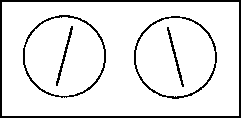A Natural History
Of Seeing
The Art and Science of Vision
Simon Ings
(Norton)
Of Seeing
The Art and Science of Vision
Simon Ings
(Norton)

- In the early 19th Century, madmen were pacified by spinning them in a chair, "into stupefied and wobbly submission."
- The first test for color-blindness occurred in Sweden in 1876, the result of a collision of two express trains. It was found that thirteen of the 266 employees "had difficulties telling red from green."
- Kangaroos can see better in the daytime, humans at night. "Marsupials evolved to fill daylit nitches ... whereas placentals evolved to occupy nocturnal nitches. Humans are the descendants of night-dwellers."
- When seeking out information, our minds provide a buffer of about a half second. "The eyes stay one step ahead of the body, dealing with the next view, the next task, the next set of predictions and calculations, while the body relies on the 'buffer.'" Thus we may "operate in the world, not as it is, but as it existed a half a second ago."
- When we look at another creature --- person, animal --- we look first at the eyes. "Being looked at matters. If something's going to fight you, or eat you, or try to mate with you, it's going to be looking at you."
- He who controls vision controls the enemy. In the Peloponnesian War, the Spartans attacked with "wood, pitch and sulphur" to incapacitate the enemy. Allies and Germans alike used phosgene gas in World War One to blind soldiers in the trenches.
- The Veiling Glare Laser, developed in Quantico, Virginia, makes "the lens of the eye fluoresce; it is painlessly, but effectively, dazzling." However, reports the author, "The long-terms risks to vision have yet to be assessed."
- Walter Bayley, physician to Queen Elizabeth I, was "a learned man who wrote on the preservation of eyesight." One of his treatments was to bathe sore eyes in urine. "Excellent advice," says our author: "Urine is sterile and mildly antibiotic."
That's OK, because there is much diverting going on here, not the least the figures at the top of each chapter heading. When you look at them, letting your eyes relax, ultimately the two-dimensional line drawings resolve themselves into a three-dimensional picture. Transfixing, it is. (I'm going to stick one at the top of this review. I have no idea if it will work on a computer screen. Look at it steadily, put your nose up close, and see if it works.)
--- Lolita Lark